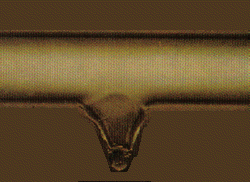 SKC Films Library SKC Films Library |
| SKC Films Library >> Science >> Chemistry >> Chemical Elements |
| Helium (He) a lightweight, colorless, odorless, and tasteless gas
Chemical Properties atomic number 2 Helium changes to a liquid when it is cooled to -268.6° C, about 4° C above absolute zero. It is the only element that cannot be changed to a solid by cooling alone. It must be both cooled and compressed. It freezes at -272° C under a pressure of 26 times atmospheric pressure. Liquid helium, unlike most other liquids, conducts heat extremely well, flows toward relatively warm places, and expands instead of contracting when it cools. Liquid helium forms a thin film over everything it touches. This film can act as a siphon, carrying the helium over the side of a container to a lower level. Occurence and Sources Helium makes up about 23 per cent of the matter in the visible universe. The Sun and other stars are made mostly of helium and hydrogen, but helium makes up only a small fraction of the Earth's matter. Most of the world's helium comes from five natural gas fields in the United States -- the Cliffside field in the Texas Panhandle; the Greenwood field in Kansas and Colorado; the Hugoton field in Kansas, Oklahoma, and Texas; the Keyes field in Oklahoma; and, the Panhandle field in Texas. Helium is purified by cooling the natural gas until all gases except helium, argon, hydrogen, and nitrogen change to liquid. Hydrogen is then burned out of the remaining mixture, and argon is absorbed by charcoal at low temperatures. Nitrogen often remains in helium as an impurity. Helium that is 99.995 per cent pure is called grade A helium; crude helium contains about half helium and half nitrogen. Uses About three-fourths of the helium produced in the United States is used by federal agencies. The government's chief use of helium is in maintaining the proper pressures in rockets. Pressure must be maintained in rocket fuel tanks during flight, or the thin walls of the large tanks might collapse as the fuel drains from them. Helium also produces the pressure that forces fuel into rocket pumping systems. The largest industrial use of helium is in heliarc welding, a type of electric arc welding. The inert helium keeps oxygen in the air from reaching the metal. If oxygen reaches the metal, it may cause the metal either to burn or to corrode. Helium is also used to prevent chemicals from reacting with other elements during storage, handling, and transportation. The most well-known use for helium is the inflation of balloons. Because helium is lighter than air, balloons can rise to high altitudes. History Evidence of helium in the Sun was discovered by English astronomer Sir Norman Lockyer in 1868. Lockyer invented the name helium from the Greek word helias, meaning sun. Helium was first found on the Earth in 1895 when the Scottish chemist Sir William Ramsay and the Swedish chemists Nils Langler and Per Theodor Cleve found it in the mineral clevite. SEE ALSO |
| SKC Films Library
>> Science >> Chemistry >> Chemical Elements This page was last updated on 06/15/2017. |
